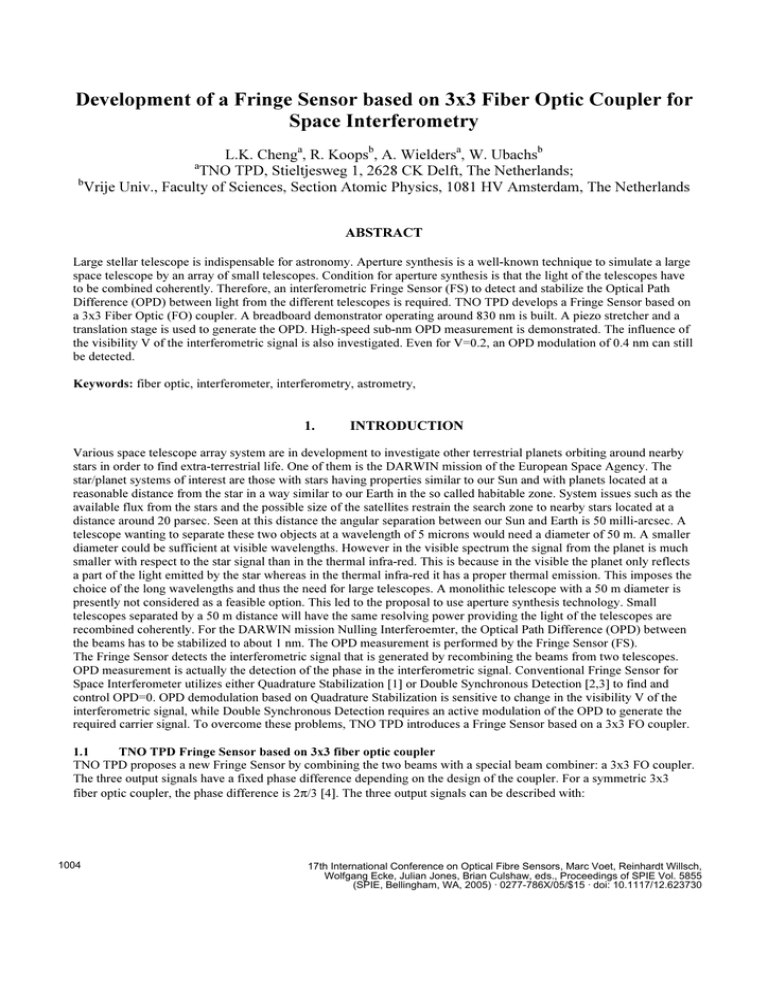Development of a Fringe Sensor based on 3x3 Fiber Optic... Space Interferometry
advertisement

Development of a Fringe Sensor based on 3x3 Fiber Optic Coupler for Space Interferometry L.K. Chenga, R. Koopsb, A. Wieldersa, W. Ubachsb TNO TPD, Stieltjesweg 1, 2628 CK Delft, The Netherlands; b Vrije Univ., Faculty of Sciences, Section Atomic Physics, 1081 HV Amsterdam, The Netherlands a ABSTRACT Large stellar telescope is indispensable for astronomy. Aperture synthesis is a well-known technique to simulate a large space telescope by an array of small telescopes. Condition for aperture synthesis is that the light of the telescopes have to be combined coherently. Therefore, an interferometric Fringe Sensor (FS) to detect and stabilize the Optical Path Difference (OPD) between light from the different telescopes is required. TNO TPD develops a Fringe Sensor based on a 3x3 Fiber Optic (FO) coupler. A breadboard demonstrator operating around 830 nm is built. A piezo stretcher and a translation stage is used to generate the OPD. High-speed sub-nm OPD measurement is demonstrated. The influence of the visibility V of the interferometric signal is also investigated. Even for V=0.2, an OPD modulation of 0.4 nm can still be detected. Keywords: fiber optic, interferometer, interferometry, astrometry, 1. INTRODUCTION Various space telescope array system are in development to investigate other terrestrial planets orbiting around nearby stars in order to find extra-terrestrial life. One of them is the DARWIN mission of the European Space Agency. The star/planet systems of interest are those with stars having properties similar to our Sun and with planets located at a reasonable distance from the star in a way similar to our Earth in the so called habitable zone. System issues such as the available flux from the stars and the possible size of the satellites restrain the search zone to nearby stars located at a distance around 20 parsec. Seen at this distance the angular separation between our Sun and Earth is 50 milli-arcsec. A telescope wanting to separate these two objects at a wavelength of 5 microns would need a diameter of 50 m. A smaller diameter could be sufficient at visible wavelengths. However in the visible spectrum the signal from the planet is much smaller with respect to the star signal than in the thermal infra-red. This is because in the visible the planet only reflects a part of the light emitted by the star whereas in the thermal infra-red it has a proper thermal emission. This imposes the choice of the long wavelengths and thus the need for large telescopes. A monolithic telescope with a 50 m diameter is presently not considered as a feasible option. This led to the proposal to use aperture synthesis technology. Small telescopes separated by a 50 m distance will have the same resolving power providing the light of the telescopes are recombined coherently. For the DARWIN mission Nulling Interferoemter, the Optical Path Difference (OPD) between the beams has to be stabilized to about 1 nm. The OPD measurement is performed by the Fringe Sensor (FS). The Fringe Sensor detects the interferometric signal that is generated by recombining the beams from two telescopes. OPD measurement is actually the detection of the phase in the interferometric signal. Conventional Fringe Sensor for Space Interferometer utilizes either Quadrature Stabilization [1] or Double Synchronous Detection [2,3] to find and control OPD=0. OPD demodulation based on Quadrature Stabilization is sensitive to change in the visibility V of the interferometric signal, while Double Synchronous Detection requires an active modulation of the OPD to generate the required carrier signal. To overcome these problems, TNO TPD introduces a Fringe Sensor based on a 3x3 FO coupler. 1.1 TNO TPD Fringe Sensor based on 3x3 fiber optic coupler TNO TPD proposes a new Fringe Sensor by combining the two beams with a special beam combiner: a 3x3 FO coupler. The three output signals have a fixed phase difference depending on the design of the coupler. For a symmetric 3x3 fiber optic coupler, the phase difference is 2π/3 [4]. The three output signals can be described with: 1004 17th International Conference on Optical Fibre Sensors, Marc Voet, Reinhardt Willsch, Wolfgang Ecke, Julian Jones, Brian Culshaw, eds., Proceedings of SPIE Vol. 5855 (SPIE, Bellingham, WA, 2005) · 0277-786X/05/$15 · doi: 10.1117/12.623730 2π OPD )). λ 2π 2π I + (OPD) = A0 (1+V cos ( OPD + )). 3 λ 2π 2π I − (OPD) = A0 (1+V cos ( OPD − )) . λ 3 (1) I S (OPD) = A0 (1+ V cos ( (2) (3) Several schemes can be used for the demodulation of the OPD from the three interferometric signals Is, I+ and I-. TNO TPD has developed an electronic signal processing board with a phase noise level of about 20 µrad/√Hz @ 1000 Hz [5]. However, this hardware board can only be used for AC signal. Therefore, another demodulation scheme has to be used for the Fringe Sensor to determine the OPD. For the presented configuration with a symmetric 3x3 coupler, the OPD can be calculated as follows: OPD = § I+ − I− λ arctan ¨¨ 3 2π 2 I s − I+ − I− © · ¸¸ . ¹ (4) In contrast to the Quadrature Stabilization, this technique is insensitive to changes in the visibility V and the amplitude A0 of the interferometric signal. In comparison to the Double Synchronous Detection, the proposed technique doesn’t require continuous active oscillation in the beam. Furthermore, this technique can be applied to the calculation of the phase term in Eq. (4) between -π/2 and +π/2 (modulo π). So, OPD stabilization can be performed within a certain range of OPD. 2. TEST SETUP A breadboard demonstrator for the Fringe Sensor based on a 3x3 FO coupler is built. The tests setup is shown in Figure 1. The light-source is a Super Luminescent Diode (or SLD) manufactured by Superlum Diodes. It has a center wavelength of 824.5nm and a bandwidth (FWHM) of 23.6nm. The symmetric couplers (2x2 and 3x3) are manufactured by Gould. The 2x2 coupler is used to split the light and to generate 2 beams for the simulation of light arriving to two telescopes. One of the fiber of the 2x2 coupler is wrapped on a piezo element to create small OPD modulation. The two beams are collimated by two optical units and are sent to the delay-lines of the Delft Testbed Interferometer (DTI) [6] which has a scanning range of about 40mm. After passing the DTI, the beams are coupled into the 3x3 FO coupler. The 3 output interferometric signals are detected by a detector unit and digitized by an AD converter (NI PCI-6110) in a computer system. The data are stored to the computer. The software demodulation of the signal is performed afterward. Figure 1 Test setup of the demonstrator Fringe Sensor based of a 3x3 FO coupler. Proc. of SPIE Vol. 5855 1005 3. TEST RESULTS Several test including the linearity, resolution and sensitivity to low visibility of the interferometric signal are performed using the breadboard demonstrator. 3.1 Linearity Different level of OPD modulation is generated using the piezo stretcher. Figure 2 shows the measured amplitude of the OPD modulation plotted against the applied voltage amplitude in terms of V0. The plots show a nicely straight line for the for both high sampling frequency (1 MHz ) as well as low sampling frequency (1 kHz). 10 10 10 (a) Measured vs Applied OPD Amplitude 2 10 am plitude peak to peak (nm ) am plitude peak to peak (nm ) 10 1 10 0 10 -1 10 -4 10 -3 10 -2 10 -1 10 (b) Measured vs Applied OPD Amplitude 2 1 0 -1 10 -4 relative applied Amplitude (in terms of V0) 10 -3 10 -2 10 -1 relative applied OPD (in terms of V0) Figure 2 Measured OPD amplitude as a function the voltage applied to the piezo for (a) 1MHz and (b) 1kHz measurements. 3.2 Resolution To investigate the high resolution capability of the breadboard demonstrator, sub-nm OPD modulation is generated using the piezo stretcher. OPD modulation remains distinguishable down to an amplitude of 0.4nm peak-to-peak for the FS operating at a sampling frequency of 1 MHz (Figure 3). The high sampling frequency can be used for averaging to improve the resolution. (see section 3.1). Measured OPD modulation 0,6 OPD (nm) 0,4 0,2 0 -0,2 -0,4 -0,6 0 0,5 1 1,5 2 time (ms) Figure 3 OPD modulation of 0.4nm can clearly be measured by the Fringe Sensor operating at a sampling frequency of 1MHz. 1006 Proc. of SPIE Vol. 5855 3.3 Influence of visibility The influence of the visibility V of the interferometric signal is also investigated. This can be realized by reducing the intensity of one of the beams. Even for V=0.2, an OPD modulation of 0.4 nm can still be detected. Plotting the measured OPD amplitude against the applied voltage amplitude shows a straight line which has remarkable resemblance with previous measurement with high visibility measurements (see section 3.1). 2 Measured vs Applied OPD Amplitude amplitude peak to peak (nm) 10 1 10 0 10 -1 10 -4 10 10 -3 -2 10 10 -1 relative applied Amplitude (in terms of V0) Figure 4 Measured OPD amplitude as a function the voltage applied to the piezo for 1MHz sampling frequency and V=0.2. 4. CONCLUSIONS A breadboard demonstrator of the Fringe Sensor based on a 3x3 FO coupler is built and tested. Linear response of the OPD demodulation is demonstrated and sub-nm resolution at 1 MHz sampling frequency is shown. The high sampling frequency can be used for averaging to improve the resolution. Reduction of the visibility of the interferometric signal down to 0.2 shows that it has hardly any effect on the resolution of the FS. REFERENCES 1. 2. 3. 4. 5. 6. Cassaing F. et al., “An optimized fringe tracker for the VLTI/PRIMA instrument”, Proc. Of SPIE, Vol. 4006, pp. 152-163, 2000. Damé, L., Derrien, M., Kozlowski, M. and Merdjane, M., “Laboratory and Sky Demonstrations of Solar Interferometry Possibilities”, ESA Meeting "A Crossroads for European Solar & Heliospheric Physics", ESA SP-417, 345-348, Tenerife, March 23-27, 1998. Damé L et al., “Solar interferometry: A revolutionary concept for high resolution solar physics”. (http://must.aerov.jussieu.fr/web_themis/proc_themis.htm) Priest R., “Analysis of fiber interferometer utilizing 3x3 fiber coupler”, Journal of Quantum Electronics, Volume 18, pp 1601-1603 Cheng L.K. and D. de Bruijn, "Fieldtest of a Fiber Optic Hydrophone", Proceedings of OFS-11, Eleventh International Conference on Optical Fiber Sensors, p. 184-187, 1996. Van Brug H.H., ‘Delft testbed interferometer: layout design and research goals’, Proceeding of SPIE, Vol. 4838, pp. 425-429, 2003. Proc. of SPIE Vol. 5855 1007


